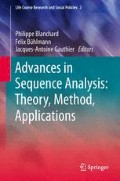Abstract
The application of prosopographical methods to the study of the Holocaust remains fairly uncommon, especially in France. In this chapter, we draw on a survey that allowed us to reconstruct “trajectories of persecution” through the Second World War, in order to discuss the difficulties and possible benefits of sequence analysis in this investigation on a cohort of about a thousand people identified as Jews and residing in Lens at the beginning of the War. Our attempts to “model” persecution and its effects on their trajectories raised a certain number of methodological issues, mostly dealing with the linearity of the causal schema implied by our approach: is it appropriate to reduce choices made under tragic circumstances to their social determinants? To conceptualize our data as “trajectories of persecution” seems to offer interesting prospects for overcoming some of these difficulties. By moving from a logic of properties to a logic of sequential states, and from a logic of causes to a logic of paths, we describe, order and interpret the plurality of trajectories, yet without abandoning quantification.
Access this chapter
Tax calculation will be finalised at checkout
Purchases are for personal use only
Notes
- 1.
Here we must recall that this mass extermination of Lens Jews actually happened in a much shorter period of time, between 11 September and the end of the month, and that the extension of the process to October is an artifact due to adopting monthly intervals as units for sequence analysis.
- 2.
Two remaining clusters were discarded from analysis and are not displayed in Table 9.5, as they mostly grouped poorly documented trajectories, either right-censored or containing important amounts of “biographical gaps”.
References
Abbott, A. (1990). A primer on sequence methods. Organization Science, 1(4), 275–392.
Abbott, A. (2001). Time matters. On theory and method. Chicago: University of Chicago Press.
Anders, E., & Dubrovskis, J. (2003). Who died in the holocaust? Recovering names from official records. Holocaust and Genocide Studies, 17(1), 114–138.
Bourdieu, P. (1980). Le sens pratique (Le sens commun). Paris: Ed. de Minuit.
Bourdieu, P. (2002). Le bal des célibataires. Crise de la société paysanne en Béarn. Paris: Seuil.
Browning, C. R. (2010). Remembering Survival: Inside a Nazi Slave Labor Camp. Chicago: W.W. Norton & Co.
Croes, M. (2006). The holocaust in the Netherlands and the rate of jewish survival. Holocaust and Genocide Studies, 20(3), 474–499.
Desrosières, A. (2001). Entre réalisme métrologique et conventions d’équivalence : les ambiguïtés de la sociologie quantitative. Genèses, 43, 112–127.
Durkheim, E. (1894). Les règles de la méthode sociologique (rééd. 1988 ed., Champs). Paris: Flammarion.
Fussell, E. (2005). Measuring the early adult life course in Mexico: An application of the entropy index. In R. MacMillan (Ed.)., The structure of the life course: Standardized? Individualized? Differentiated? (pp. 91–122). Amsterdam: Elsevier.
Gabadinho, A., Ritschard, G., Mueller, N. S., & Studer, M. (2011). Analyzing and visualizing state sequences in R with TraMineR. Journal of Statistical Software, 40(4), 1–37.
Gross, M. (1994). Jewish rescue in holland and France during the second world war: Moral cognition and collective action. Social Forces, 73(2), 463–496.
Klarsfeld, S. (2012). Mémorial de la déportation des Juifs de France: Paris, Fils et Filles des Déportés Juifs de France (FFDJF).
Lemercier, C., & Zalc, C. (2008). Méthodes quantitatives pour l’historien. Paris: La Découverte.
Lesnard, L. (2010). Cost setting in optimal matching to uncover contemporaneous socio-temporal patterns. Sociological Methods & Research, 38(3), 389–419.
Macindoe, H., & Abbott, A. (2010). Sequence analysis and optimal matching techniques for social science data. In A. Bryman & M. A. Hardy (Ed.), Handbook of data analysis (pp. 387406). London: Sage.
Mariot, N., & Zalc, C. (2010). Face à la persécution. 991 Juifs dans la guerre. Paris: Odile Jacob. Fondation pour la Mémoire de la Shoah.
Mariot, N., & Zalc, C. (2012). Destins d’une communauté ou communauté de destins? Approche prosopographique. In T. Bruttmann, I. Ermakoff, N. Mariot & C. Zalc (Ed.), Pour une microhistoire de la Shoah (pp. 73–96). Paris: Seuil.
Mendelsohn, D. (2006). The lost: A search for six of six million. Scarborough: HarperCollins.
Mercklé, P. (2011). Sociologie des réseaux sociaux. Paris: La Découverte.
Pollak, M. (1990). L’expérience concentrationnaire. Essai sur le maintien de l’identité sociale. Paris: Métailié.
R Core Team (2013). R: A language and environment for statistical computing. Vienna: R Foundation for Statistical Computing. URL: http://www.R-project.org/. Accessed on 17 october 2013.
Tammes, P. (2007). Jewish Immigrants in the Netherlands during the Nazi Occupation. Journal of Interdisciplinary History, XXXVII(4), 543–562.
Author information
Authors and Affiliations
Corresponding author
Editor information
Editors and Affiliations
Rights and permissions
Copyright information
© 2014 Springer New York Heidelberg Dordrecht London
About this chapter
Cite this chapter
Mercklé, P., Zalc, C. (2014). Trajectories of the Persecuted During the Second World War: Contribution to a Microhistory of the Holocaust. In: Blanchard, P., Bühlmann, F., Gauthier, JA. (eds) Advances in Sequence Analysis: Theory, Method, Applications. Life Course Research and Social Policies, vol 2. Springer, Cham. https://doi.org/10.1007/978-3-319-04969-4_9
Download citation
DOI: https://doi.org/10.1007/978-3-319-04969-4_9
Published:
Publisher Name: Springer, Cham
Print ISBN: 978-3-319-04968-7
Online ISBN: 978-3-319-04969-4
eBook Packages: Humanities, Social Sciences and LawSocial Sciences (R0)

